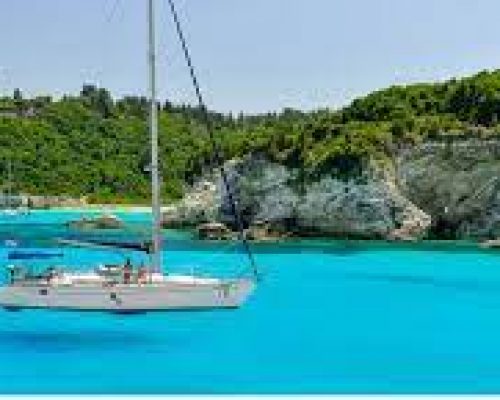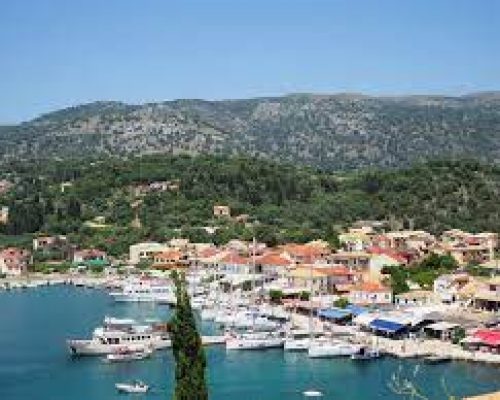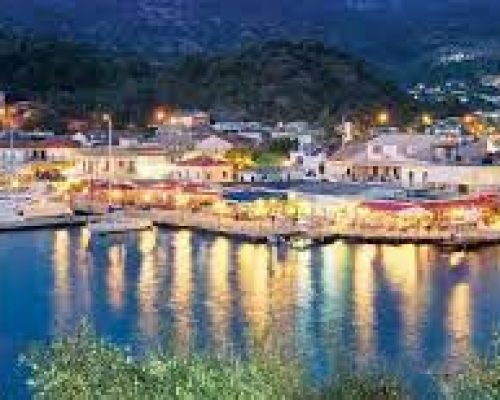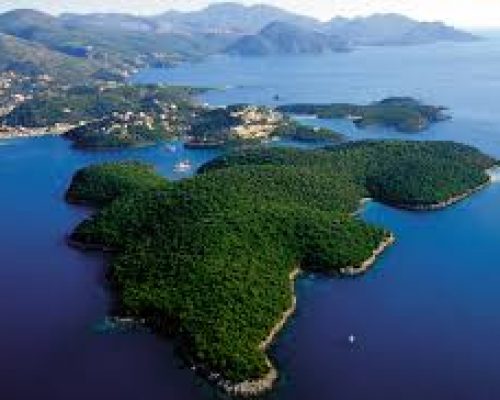







DISCOVER SIVOTA
Syvota is a small coastal village in the prefecture of Thesprotia in Epirus, known for its cluster of green islands (Agios Nikolaos, Mavro Oros, Megalo and Mikro Mourtemeno) and its crystal beaches, some accessible by land and others only by sea.
In recent years it has experienced a great tourist boom and offers many accommodations in the center of the village and on the isolated slopes that surround the settlement
The heart of Sivota beats in the small harbor, which is full of taverns, restaurants, cafes and bars, with a view of the sailing boats, speedboats and boats that leave daily for the beaches of the area and the nearby islands - Corfu (in the south section), Paxos and Antipaxos. Early in the morning, boats are offered for rent with which one can tour around the islets, visit the cave with the stalactites, swim at the beaches that are only accessible from the sea, at the Diapori pass and at the famous Pisina beach, with its emerald waters.
In the evening, the scene in the center of Sivota changes, with people walking around the streets, browsing the shops with folk art items, decorations, summertime and sea items, etc., and of course taking a seat in some tavern /restaurant to enjoy his dinner. At the time when the sun sets, everything around turns purple!
In Sivota you will find general tourism agencies, where they will organize a day trip for you, you can rent a sailing boat, a small motorized boat, a bicycle, take part in a road trip getting to know Thesprotia and the surrounding area, go diving, parasailing, etc. There is also a roller coaster which approaches the beaches of Megali and Mikri Ammos, Mega Drafi reaching Agia Paraskevi.
HISTORY
The name Syvota is assumed to come from two ancient words sys (pig) and graze, because before it was inhabited, herds of pigs grazed in this area. Another etymology accepts that the name means the cluster of islands.
Sivota is mentioned in the books of the historian Thucydides, as in 432 BC. in the maritime area of the area, the famous naval battle of Sivota took place, in which the Corinthian and Thesprotic fleets fought the Corfu fleet belonging to the opposing faction, the Athenian, during the Peloponnesian War. In the wider waters of the area, it is believed that there are the wrecks of the warships that sank at that time.
The first settlement was created during the Ottoman rule in the 15th century AD. on a hill in the area and was called Vrachonas. Many of these stone houses are still preserved in ruins but unfortunately most of them were torn down in recent years either to use their stones elsewhere or to find hidden gold pounds or to create pastures. A few houses of a similar architectural style from this era can be found in ruins on other slopes around the port.
Shortly before the end of the Ottoman rule around 1850 AD. the first houses began to be built on the coasts of the area so that the inhabitants could take advantage of the traffic of ships in the narrow passage between the islands. Among them was a pirate named Murtos who robbed passing ships or sometimes taxed them. At that time the village took the name Mourtos or Volia and agriculture and fish farming started developing.
The port of Sivota was used during the Greek Revolution as the headquarters of the Ottoman rear admiral and in June 1822 the revolutionary Kyriakoulis Mavromichalis attacked the port, occupied it but was forced to leave after the demand of English officers from the neighboring Eptanisa.
It was liberated from the Ottoman rule on February 23, 1912-13 and many Epirotians from the mountains of Pindos and the regions of Ioannina moved to Sivota (which regained its ancient name in 1959) and settled there, developing the economy of the region.
BEACHES
Sivota is an ideal destination for sea trips by sailing boat or speedboat, as the distances to the surrounding islets are short. And the beaches and sheltered harbors, as well as the beautiful bays where you can tie a rod, offer truly unforgettable moments. Also, most beaches are a few minutes away either by foot or by car.
Starting from the center of Sivota, from its square, begins the road that leads to the beaches of Bella Vraka and Karvouno.
Η Bella Vraka (800 m. from the settlement and 200 m. downhill path) is one of the famous beaches located on the islet of Mourtemeno and you reach it by crossing the sea. It is a small sandy beach, while a water sports company operates there, which however only serves the customers of the specific hotel.
Karvouno beach (400 m. from the settlement) is a small cove with a hotel and sunbeds, umbrellas.
At 1 km from the village of Syvota in the direction of Parga, at 100 m on the right, is Zavia beach. Small picturesque bay surrounded by greenery, with canteen, sunbeds, umbrellas, motorboat, canoe, bicycle rentals. Right next to it, there is a small beach with pebbles, where the waters alternate from cold to warm, and vice versa, due to the springs that are present.
At 2 km you reach the cosmopolitan Megali Ammo, awarded with a "Blue Flag", with beach bars, cafes, a couple of taverns, rentals and hotels all around.
The next beach is Mikri Ammosalso cosmopolitan with a fancy beach bar and restaurant.
Megalo and Mikro Drafi (3.7 km + 100 m.) are beaches with pebbles and sand, the first has a refreshment stand, sunbeds, umbrellas, while on the second one there are no such facilities.
Agia Paraskevi (6 km + 300 m.) awarded with the "Blue Flag", overlooks the green rocky islet, is a beautiful beach with a cafe, restaurant, fish tavern, rooms for rent, hotels in the area. Next is Sofas with camping, while for Arilla and Karavostasi beaches you will travel 17 km from Sivota. They are organized beaches with a tourist infrastructure, while Karavostasi is an award-winning beach with a "Blue Flag".
From the western side of the port in Sivota, at a distance of 200 m - 2 km you reach the beaches of Gallikos Molos, Zeri, Dei.
At least you can reach Gallikos Molos (French Pier) on foot, following the Path of Lovers from the edge of the port, which after 150 m ends at the beach. There is a tourist business with a cafe, restaurant and rooms to rent, and it is also very beautiful for the sunset. The beach also has umbrellas and sunbeds.
Zeri is a beach with a beach bar and restaurant.
On the DEI beach, a green cove (there are also sunbeds, umbrellas) there is a refreshment bar with seats under the shade of the trees, serving drinks and snacks, while in July and August it will also have grilled meats and Greek salad. Next to the edge of the beach there is a steep path that leads to a smaller isolated beach called Mikri Dei.
Finally, regarding Pisina and Diapori beaches, where the approach is only by sea, the famous Pisina gathers a lot of people (it is also approached by tourist boats coming from Paxos and Corfu), while Diapori has crystal clear, shallow waters, and its beach is small. Both beaches are unorganised. Also only accessible by sea is the beach after the small PPC to the West called Plakaries, which is known for the slabs that are stacked on top of each other.
EXCURSIONS
To the islets of Sivota, with daily departures from the port, with routes starting at 09.30 in the morning and ending at 18.00. Two companies are active, with departures every hour (so one company has itineraries every full hour and the other every half hour - 09.30, 10.30, 11.30 etc.). The tour around the islets - Agios Nikolaos, Mavro Oros, Megalo and Mikro Mourtemeno - lasts about 30-40 minutes, the cave with the stalactites is visited, the boat passes Diapori and arrives at the famous Pisina beach, with its emeralds waters. You have the possibility to stop for a swim at both beaches.
DAILY CRUISES to Paxos and Antipaxos are carried out from the port of Sivota. Specifically, there is the short tour, departing at 09.30, arriving in Antipaxos, after an hour and a half, staying and swimming at Voutumi beach, then visiting the caves and stopping in Gaios, the port of Paxos, for two hours. Departure from Sivota at 09.30 and return at 17.00. Accordingly, the grand tour takes place on Thursday, with an approach to Lakka, a picturesque settlement north of Paxos. Day trips are also available to Corfu
TIPS
- Path of Lovers: From the edge of the port, to the west, begins the shady path of lovers, where after 150 m it ends at the beach of Gallikos Molos. Among other things, it is also an ideal spot for sunset.
- Shipwreck: Diving enthusiasts can dive to 63 meters deep and see up close the British minesweeper H.M.S. Regulus (J 327). The warship sank on January 12, 1945 after striking a mine.
- Plataria: Beautiful authentic fishing village with a harbor - marina where boats can be moored, view of Plataria bay, long sandy beach, rentals, amazing tavernas on the sea serving fresh fish and seafood, beach bars. It is 9 km from Sivota and 12 km from Igoumenitsa.
- Perdika: At a distance of 12 km east from Sivota, on the provincial road to Parga, the mountainous Perdika - the largest traditional village of Thesprotia – offers a view of Corfu and Paxos and is famous for the grilled meats offered by its taverns. Visit the folklore museum, but also the Recreation Park, a beautiful location with waterfalls, bridges, which also serves as a wildlife sanctuary. Around Perdika, you will swim in beaches such as Karavostasi, Arillas, Prapa Malli with difficult access (they also prefer it for free camping), etc., you will taste excellent delicacies, etc.
- Dymokastro: In Karavostasi, there is Dymokastro, the castle of the ancient city of Elina, which dates back to the 4th century BC. It is built on top of the southern hill
- Parga: Follow the 27km route and you'll reach the picturesque Parga with its colorful, amphitheater-built houses, fine arcade and uphill alleys leading to its Venetian castle. All around there are beaches for all tastes such as Valtos, Lychnos, Piso Kryoneri, Ai Giannakis, etc.
- Sources of the Acheron: A nearby excursion of 40 km is the crossing of the river Acheron to its sources. The river Acheron (the river of sorrow) was the river where, according to the ancient Greeks, Hermes delivered the souls of the dead to Charon to end up in Hades. Today one can cross the gorge, hike from the village of Glyki or boat from the estuary to the village of Ammoudia, swim in the river, go rafting, kayaking, horse riding. Beach shoes and swimwear are a must! Don't be put off by the water temperature. The higher you go, the greater the beauty of the river, especially at the point where the mountains form a ravine and the waters deepen and allow you to take a dip. Five kilometers further in the village of Mesopotamos, you can also visit the Necromanteion of Acheron from the 4th-3rd century BC. Don't miss the chance to see the underground crypt with its 15 archways, where the ancient Greeks are said to have contacted their dead. The atmosphere submits.
- Igoumenitsa: Capital of Thesprotia and Seat of the municipality of the same name (22 km from Syvota), it is the most important port of communication between Greece and Western Europe, but also the end of the Egnatia highway. The port of Igoumenitsa is geographically the closest port of Greece to Italy and the Balkan countries of the Adriatic Sea. At a distance of 5 km is the "Blue Flag" awarded Drepano beach.
- Kalamas River: Kalamas – Thyamis is the largest river in Epirus and the most important wetland in Western Greece. Its sources are in the mountains of Ioannina and it flows into the Ionian sea. The Kalamas Delta is protected by the Natura 2000 network.

